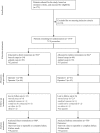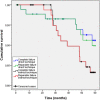Randomized control trial of composite cuspal restorations: five-year results
- PMID: 24155264
- PMCID: PMC3872857
- DOI: 10.1177/0022034513510946
Randomized control trial of composite cuspal restorations: five-year results
Abstract
The objective of this randomized control trial was to compare the five-year clinical performance of direct and indirect resin composite restorations replacing cusps. In 157 patients, 176 restorations were made to restore maxillary premolars with Class II cavities and one missing cusp. Ninety-two direct and 84 indirect resin composite restorations were placed by two operators, following a strict protocol. Treatment technique and operator were assigned randomly. Follow-up period was at least 4.5 yrs. Survival rates were determined with time to reparable failure and complete failure as endpoints. Kaplan-Meier five-year survival rates were 86.6% (SE 0.27%) for reparable failure and 87.2% (SE 0.27%) for complete failure. Differences between survival rates of direct and indirect restorations [89.9% (SE 0.34%) vs. 83.2% (SE 0.42%) for reparable failure and 91.2% (SE 0.32%) vs. 83.2% (SE 0.42%) for complete failure] were not statistically significant (p = .23 for reparable failure; p = .15 for complete failure). Mode of failure was predominantly adhesive. The results suggest that direct and indirect techniques provide comparable results over the long term (trial registration number: ISRCTN29200848).
Keywords: clinical studies/trials; composite materials; operative dentistry; prosthetic dentistry/prosthodontics; restorative dentistry; restorative materials.
Conflict of interest statement
The authors received no financial support and declare no potential conflicts of interest with respect to the authorship and/or publication of this article.
Figures




Similar articles
-
Five-year clinical effectiveness of a two-step self-etching adhesive.J Adhes Dent. 2007 Feb;9(1):7-10. J Adhes Dent. 2007. PMID: 17432395 Clinical Trial.
-
In vitro comparison of microleakage of posterior resin composites with and without liner using two-step etch-and-rinse and self-etch dentin adhesive systems.Oper Dent. 2011 Mar-Apr;36(2):213-21. doi: 10.2341/10-215-L. Epub 2011 Jun 24. Oper Dent. 2011. PMID: 21702678 Clinical Trial.
-
Marginal and internal adaptation of bulk-filled Class I and Cuspal coverage direct resin composite restorations.Oper Dent. 2007 Sep-Oct;32(5):515-23. doi: 10.2341/06-157. Oper Dent. 2007. PMID: 17910230 Clinical Trial.
-
Assessment of laminate technique using glass ionomer and resin composite for restoration of root filled teeth.J Dent. 2012 Aug;40(8):617-23. doi: 10.1016/j.jdent.2012.04.006. Epub 2012 Apr 20. J Dent. 2012. PMID: 22521705 Clinical Trial.
-
Predictable bonding of adhesive indirect restorations: factors for success.Br Dent J. 2021 Sep;231(5):287-293. doi: 10.1038/s41415-021-3336-x. Epub 2021 Sep 10. Br Dent J. 2021. PMID: 34508198 Free PMC article. Review.
Cited by
-
Survival of Prosthodontic Restorations Luted with Resin-Based versus Composite-Based Cements: Retrospective Cohort Study.Materials (Basel). 2022 Jan 2;15(1):312. doi: 10.3390/ma15010312. Materials (Basel). 2022. PMID: 35009458 Free PMC article.
-
Direct Composite Restorations on Permanent Teeth in the Anterior and Posterior Region - An Evidence-Based Clinical Practice Guideline - Part 1: Indications for Composite Restorations.J Adhes Dent. 2024 Sep 17;26:185-200. doi: 10.3290/j.jad.b5748881. J Adhes Dent. 2024. PMID: 39286910 Free PMC article.
-
Comparative Evaluation of Two Different Fiber-Reinforced Composite Materials in Class 1 Post-Endodontic Restorations in Molars-A Randomized Clinical Study.Materials (Basel). 2022 Nov 7;15(21):7858. doi: 10.3390/ma15217858. Materials (Basel). 2022. PMID: 36363448 Free PMC article.
-
Short fiber reinforced composite: a new alternative for direct onlay restorations.Open Dent J. 2013 Dec 30;7:181-5. doi: 10.2174/1874210601307010181. eCollection 2013. Open Dent J. 2013. PMID: 24511331 Free PMC article.
-
Interfacial Effects Between Dental Impression and Die Materials and Their Role in the Internal Fit of Indirect Resin-Based Composite Restorations.Dent J (Basel). 2025 Mar 31;13(4):155. doi: 10.3390/dj13040155. Dent J (Basel). 2025. PMID: 40277485 Free PMC article.
References
-
- Aggarwal V, Logani A, Jain V, Shah N. (2008). Effect of cyclic loading on marginal adaptation and bond strength in direct vs. indirect class II MO composite restorations. Oper Dent 33:587-592 - PubMed
-
- Bader JD, Martin JA, Shugars DA. (2001). Incidence rates for complete cusp fracture. Community Dent Oral Epidemiol 29:346-353 - PubMed
-
- Boutron I, Moher D, Altman DG, Schulz KF, Ravaud P; CONSORT Group (2008). Extending the CONSORT statement to randomized trials of nonpharmacologic treatment: explanation and elaboration. Ann Intern Med 148:295-309 - PubMed
-
- Coelho-De-Souza FH, Camacho GB, Demarco FF, Powers JM. (2008). Fracture resistance and gap formation of MOD restorations: influence of restorative technique, bevel preparation and water storage. Oper Dent 33:37-43 - PubMed
-
- de Paula AB, Duque C, Correr-Sobrinho L, Puppin-Rontani RM. (2008). Effect of restorative technique and thermal/mechanical treatment on marginal adaptation and compressive strength of esthetic restorations. Oper Dent 33:434-440 - PubMed
Publication types
MeSH terms
Substances
Associated data
LinkOut - more resources
Full Text Sources
Other Literature Sources

